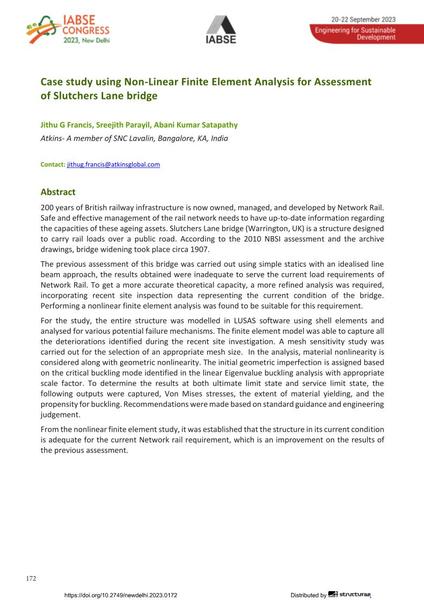Case study using Non-Linear Finite Element Analysis for Assessment of Slutchers Lane bridge

|
|
|||||||||||
Bibliographic Details
| Author(s): |
Jithu G. Francis
(Atkins- A member of SNC Lavalin, Bangalore, KA, India)
Sreejith Parayil (Atkins- A member of SNC Lavalin, Bangalore, KA, India) Abani Kumar Satapathy (Atkins- A member of SNC Lavalin, Bangalore, KA, India) |
||||
|---|---|---|---|---|---|
| Medium: | conference paper | ||||
| Language(s): | English | ||||
| Conference: | IABSE Congress: Engineering for Sustainable Development, New Delhi, India, 20-22 September 2023 | ||||
| Published in: | IABSE Congress New Delhi 2023 | ||||
|
|||||
| Page(s): | 172-181 | ||||
| Total no. of pages: | 10 | ||||
| DOI: | 10.2749/newdelhi.2023.0172 | ||||
| Abstract: |
200 years of British railway infrastructure is now owned, managed, and developed by Network Rail. Safe and effective management of the rail network needs to have up-to-date information regarding the capacities of these ageing assets. Slutchers Lane bridge (Warrington, UK) is a structure designed to carry rail loads over a public road. According to the 2010 NBSI assessment and the archive drawings, bridge widening took place circa 1907. The previous assessment of this bridge was carried out using simple statics with an idealised line beam approach, the results obtained were inadequate to serve the current load requirements of Network Rail. To get a more accurate theoretical capacity, a more refined analysis was required, incorporating recent site inspection data representing the current condition of the bridge. Performing a nonlinear finite element analysis was found to be suitable for this requirement. For the study, the entire structure was modelled in LUSAS software using shell elements and analysed for various potential failure mechanisms. The finite element model was able to capture all the deteriorations identified during the recent site investigation. A mesh sensitivity study was carried out for the selection of an appropriate mesh size. In the analysis, material nonlinearity is considered along with geometric nonlinearity. The initial geometric imperfection is assigned based on the critical buckling mode identified in the linear Eigenvalue buckling analysis with appropriate scale factor. To determine the results at both ultimate limit state and service limit state, the following outputs were captured, Von Mises stresses, the extent of material yielding, and the propensity for buckling. Recommendations were made based on standard guidance and engineering judgement. From the nonlinear finite element study, it was established that the structure in its current condition is adequate for the current Network rail requirement, which is an improvement on the results of the previous assessment. |
||||
| Keywords: |
finite element analysis FEA non-linear analysis geometric nonlinearity material nonlinearity Eigen value Analysis
|
||||
